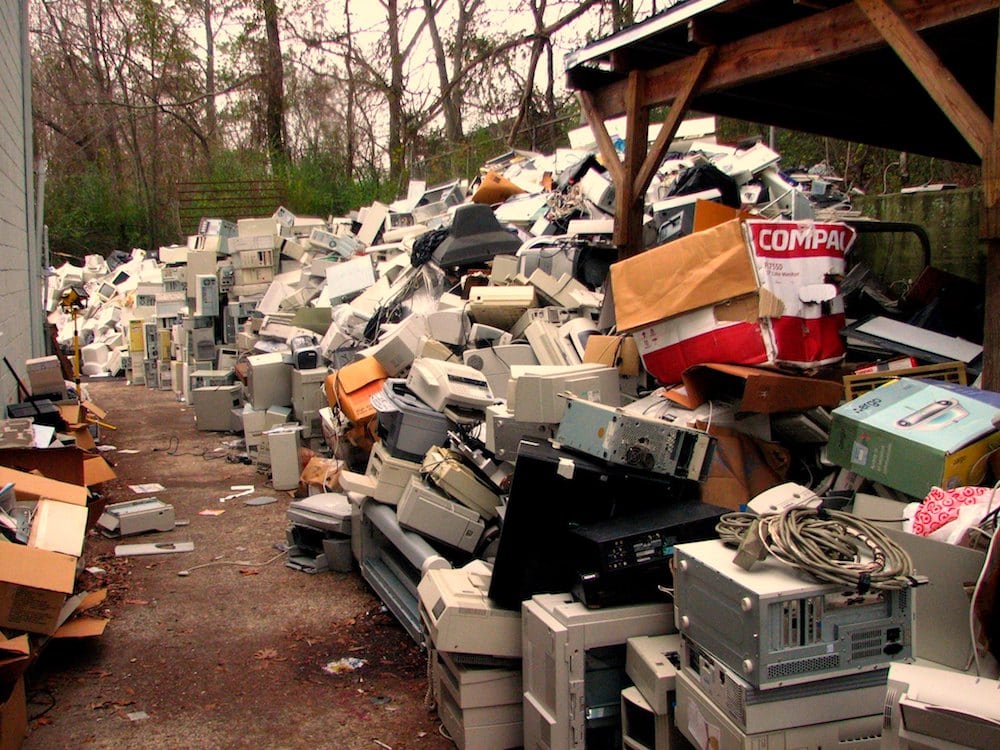
[Image above] Do you know where your recycled electronics really end up? Credit: Curtis Palmer, Flickr (CC BY 2.0)
When it comes to holiday gifts, odds are high that you will receive at least one electronic device—74% of adults in the United States plan on buying tech items this year, according to a Consumer Technology Association survey.
But as you unwrap your new iPhone or smart TV, it is also time to consider what to do with your old electronics.
Currently, only about 20% of the almost 45 million metric tonnes (Mt) of electronic waste worldwide are recycled each year, according to a recent United Nations report. The U.S. produces about 6.3 million Mt, or 14%, of this waste and recycles close to 25%.
Although the above-average U.S. rate appears relatively good, it unfortunately hides a dark truth—many “recyclers” are not recycling e-waste but rather exporting it to developing countries.
Dangers of unregulated recycling
When e-waste is sent to developing countries, the electronics by and large are not recycled. Instead, minerals are extracted via improper methods (for example, circuit boards are bathed in nitric and hydrochloric acid to recover gold, which poisons waterways) and unused parts are dumped improperly in the ground or burned, releasing toxic pollutants like hydrocarbon ashes into the air, water, and soil.
In many cases, workers handling these toxic materials are poorly educated and do not know the materials will negatively affect their health. A CNN article from 2013 looking at e-waste in China illustrates the ramifications on local populations.
“Studies by the Shantou University Medical College revealed that many children tested in Guiyu had higher than average levels of lead in their blood, which can stunt the development of the brain and central nervous system,” the article states.
The article also highlights how toxicity extends beyond the immediate area. “Officials in Guangzhou city, roughly 400 kilometers away from Guiyu, found high rates of cadmium in rice and rice products,” the article adds.
The Basel Convention
In May 1992, The Basel Convention on the Control of Transboundary Movements of Hazardous Wastes and their Disposal entered into force. The international treaty was designed to reduce movement of hazardous waste between nations and specifically to prevent transfer of hazardous waste from developed to less developed countries.
As of October 2018, 186 states and the European Union are parties to the Convention.
Unfortunately, although the U.S. signed the Convention in 1990, it still has not ratified it, and currently no U.S. legislation outlaws export of hazardous wastes to developing countries.
(The U.S. also actively opposed the Basel Ban Amendment, which prohibits export of hazardous wastes from member states of the European Union, Organization for Economic Cooperation and Development (OECD), and Liechtenstein to all other countries. The Ban Amendment entered into force on December 5, 2019.)
The Basel Action Network: Stopping toxic e-waste trade
Although the U.S. does not outlaw export of hazardous wastes to developing countries, it does outlaw lying to clients about where recycling waste goes. And this legislation is what gives the Basel Action Network (BAN) a way to bring unethical recyclers to task.
BAN is a nonprofit organization dedicated to preventing pollution dumping in developing countries. It currently tackles three toxic waste streams covered by the Basel Convention:
- E-waste
- End-of life ships
- Plastic pollution
BAN was founded in 1997 by Jim Puckett, an environmental health and justice advocate. Puckett and BAN have exposed numerous companies’ unethical recycling practices since BAN’s inception, and in 2009 they created an e-Stewards Certification Program, which certifies the most socially and environmentally responsible e-recyclers to the e-Stewards Standard.
Shady e-recyclers revealed
In 2015, BAN partnered with the Massachusetts Institute of Technology to conduct the e-Trash Transparency Project, a two-year project that involved placing 200 small GPS-based tracking devices into old printers and monitors and delivering the items to various recyclers around the country. A video from EarthFix in 2016 takes a look behind the scenes of the project.

Credit: EarthFixMedia, YouTube
The goal of e-Trash Transparency was to learn the extent of e-waste being sent overseas. But BAN learned more than they bargained for when GPS trackers revealed one of their long-time e-Stewards partners, Total Reclaim, was secretly shipping e-waste overseas as well.
In a recent in-depth feature article and video by The Verge, the details of BAN’s discovery and Total Reclaim’s betrayal are expertly recounted.

Credit: Verge Science, YouTube
So what can you do to ensure electronics are recycled ethically? BAN’s e-Stewards program includes a “Find a Recycler” page that helps you locate responsible e-recyclers. And if you want legislation regulating toxic e-waste exports, you can write your Congressperson about ratifying the Basel Convention.
Author
Lisa McDonald
CTT Categories
- Electronics
- Environment
Spotlight Categories
- Member Highlights


